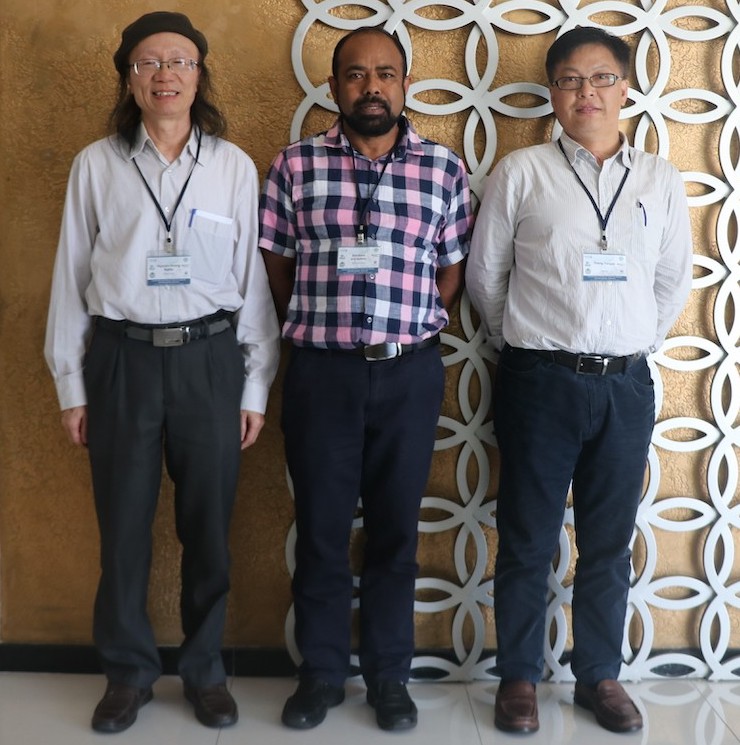Dr. Nghia, why is the conservation of forest genetic resources considered important in Vietnam? How have the conservation priorities evolved over the years?
NHN: In 1987, the Vietnamese Government issued a temporary decree for genetic conservation. The goal was to conserve the genetic resources of animals, forest plants, medicinal plants, and others. The government gave money to conservation organizations for research projects. Funding from that decree has continued to this day.
There are two kinds of research that fall under that decree and are funded by the government; one is in regards to tree improvement of commercially important species such as acacias and eucalypts. Another is in regards to genetic resources of native or precious species.
Dr. Bandara, can you tell me a bit about your work at the Sri Lanka Forestry Institute and what projects you're working on currently that are related to forest genetic resources?
BA: The Sri Lanka Forestry Institute is involved in both research and education, but our mandate is to provide education. Before I became Director of the Sri Lanka Forestry Institute, I was a researcher. My specialization is in forest genetics and tree breeding.
The Forest Research Centre is a small office, and since we do not have many researchers, I am still contributing to breeding and genetic research. Specifically, I am doing research on eucalypts, teak, mahogany, and acacias. Those are the commercial plantation tree species in the country.
Sri Lanka has pledged to restore 200,000 ha of degraded forests by 2030 to increase the forest cover 32% from the existing 29.7%. What species or ecosystems are a priority for restoration, and where is the propagation material coming from?
BA: This pledge focuses not only commercial species in Sri Lanka, but on native species as well. It is a challenging undertaking, as it considers many species.
At the moment we do not have a proper plan regarding where the propagation material will come from. We have not identified seed production areas, so as of right now, materials are coming from natural populations.
Another challenge is that, even though Sri Lanka is a small country, it has many ecological regions and ecosystem types. This makes it difficult to identify many seed production areas for each ecoregion.
The work is still in its early stages, but the Forest Department has a plan for universities, and other institutions to collaborate to address these isues, which is a great first step.
Dr. Yongqi, you initiated the Regional Training Centre on Forest Genetic Resources. What caused you to see a need for the training center?
ZY: The capacities of the countries in the region differ in terms of the conservation and utilization of forest genetic resources. In some countries, institutional capacity is particularly weak. We want to help improve that capacity among APFORGEN member countries. A regional training center could strengthen national capacities in FGR conservation by providing trainings on FGR conservation and utilization. So far, these training sessions have been popular and successful. The next training session is in October and will be the fourth training session we organize.
Funding for the training activities is a burning issue for the Regional Training Center. We have tried very hard to attract interests from the private sector by providing technical support to help companies improving their competence in reforestation, landscaping and restoration. Companies can also get a positive social reputation by promoting FGR conservation. China Happy Ecology is the private company that has invested in the Training Centre.
What future plans do you have in mind for the Training Centre?
ZY: Currently, I am trying to keep track of governmental interests. We need to think more about how to get support from the government, as opposed to just private companies. The National Forestry and Grassland Administration (NFGA) of China has expressed interest in the Training Centre. The challenge is that we need to create a proposal that meets the requirements of the government.
All of you are from different countries. What makes regional collaboration so important?
NHN: In Vietnam in the 1970s, we started species provenance trials to study adaptation of seed of different origins and identify good planting material for different areas. At that time we needed seed from Australia, China, and other countries in the region. It is still the same today. We need to collaborate in order to exchange materials that are important to conservation.
Is it complicated to exchange seed between countries in the region?
NHN: For common tree species, like acacia species, exchanging seed between countries is easy. It is only in the case of rare species that the exchange of seed between countries becomes difficult.
BA: I would agree with Dr. Nghia. It is not difficult to exchange material of some commercial species such as eucalypts and acacias. We also have the seed production areas and seed orchards for those species to meet the demand for genetic materials. However, it is difficult to exchange the genetic materials of many restoration species.
ZY: I have found that while in theory there are no problems when it comes to exchanging seeds between countries, there are some challenges in practice. The Nagoya Protocol on Access and Benefit Sharing is certainly a concern when transferring FGR across countries. We need to develop an acceptable and workable model for collaboration in terms of the exchange of seeds and other plant materials. Currently, China is trying to revise national regulations that enable researchers to have greater access to genetic resources. But that process takes a long time.
BA: Another reason for collaboration is that many countries now have their own forest restoration programs. When it comes to these programs, I think that the sharing of methodologies and scientific knowledge between countries is also very important.
NHN: That is true, and language is also an important issue. In the cases of Vietnam or China, papers are published in Vietnamese and Chinese. Very few papers are published in English, which is a challenge. There is a lot of information that is being produced in Vietnamese and Chinese, but it is difficult for people who speak other languages to get access to that information. Funding to publish works on forest genetic resources in English would be very good for the region. Even things like informational handbooks in English would be quite beneficial.
What are some of your hopes for the future of APFORGEN?
ZY: I have been thinking about the strategical direction of the network. Traditionally, the subject of forest genetic resources was mixed with the subject of tree genetics and breeding. Today they are increasingly distinguished from each other as separate disciplines with clearly different focuses. Tree breeding focuses on specific breeding objectives; for example, fast-growth or high wood density. Forest genetic resources, alternatively, focuses on the genetic diversity and variation of trees, or in other words, the uniqueness of characteristics.
APFORGEN is focused on forest genetic resources, therefore conservation and use of genetic diversity should be given priority. We need to conserve trees that are unique or different, with actual or potential values for use. I have been trying to convince government sectors that we need to conserve not only the “good,” but the “bad” characteristics for the sake of genetic diversity. I think that it would be beneficial for APFORGEN to focus on the use of genetic resources as well as conservation. I also think that we need to consider how we link APFORGEN with the governments of member countries. This would result in each member country having more support.
BA: Yes, most of the countries in the region focus more on restoration of the degraded forests and conservation of the natural forests than they do on the commercial plantation establishment. Landscape restoration has been a recent approach to restoration as opposed to the restoration of small sites. However, all restoration programs need a very good forest genetic resources conservation and use mechanism between the countries within the region.
Whether we like it or not, we should not totally forget about the plantation sector. At the moment we are facing with a large challenge when it comes to getting good genetic materials for both plantation forestry programs and for forest restoration programs. Therefore, conservation and sustainable use of FGRs is an important issue to address through the collaboration within the Asia pacific region.
Read more about APFORGEN's regional initiatives to support conservation, restoration and sustainable use of forest genetic resources.

